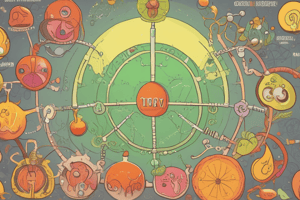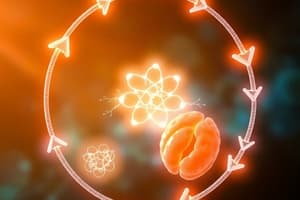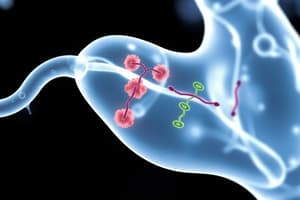Podcast
Questions and Answers
Where does the citric acid cycle occur in eukaryotes?
Where does the citric acid cycle occur in eukaryotes?
- Plasma membrane
- Inner mitochondrial membrane
- Cytosol
- Mitochondrial matrix (correct)
Which stage of cellular respiration generates the vast majority of ATP during catabolism?
Which stage of cellular respiration generates the vast majority of ATP during catabolism?
- Stage 1
- Stage 2
- Glycolysis
- Stage 3 (correct)
What is the location of oxidative phosphorylation in eukaryotes?
What is the location of oxidative phosphorylation in eukaryotes?
- Inner mitochondrial membrane (correct)
- Plasma membrane
- Cytosol
- Mitochondrial matrix
In which stage of cellular respiration are remaining carbon atoms from carbohydrates, amino acids, and fatty acids released?
In which stage of cellular respiration are remaining carbon atoms from carbohydrates, amino acids, and fatty acids released?
What is the main function of the TCA cycle in cellular metabolism?
What is the main function of the TCA cycle in cellular metabolism?
Flashcards
Citric Acid Cycle Location
Citric Acid Cycle Location
The citric acid cycle occurs in the mitochondrial matrix of eukaryotic cells.
ATP Generation Stage
ATP Generation Stage
Oxidative phosphorylation, the third stage, is the main ATP producer in cellular respiration.
Oxidative Phosphorylation Location
Oxidative Phosphorylation Location
Oxidative phosphorylation takes place in the inner mitochondrial membrane of eukaryotes.
Stage 2 Release
Stage 2 Release
Signup and view all the flashcards
TCA Cycle Role
TCA Cycle Role
Signup and view all the flashcards
Study Notes
Cellular Respiration
- In eukaryotes, the citric acid cycle occurs in the mitochondrial matrix.
- The vast majority of ATP during catabolism is generated in the oxidative phosphorylation stage.
- Oxidative phosphorylation takes place in the mitochondrial inner membrane in eukaryotes.
- The remaining carbon atoms from carbohydrates, amino acids, and fatty acids are released in the citric acid cycle stage.
- The main function of the TCA (Tricarboxylic Acid) cycle, also known as the citric acid cycle, is to generate energy for the cell by producing ATP, NADH, and FADH2 during cellular metabolism.
Studying That Suits You
Use AI to generate personalized quizzes and flashcards to suit your learning preferences.




